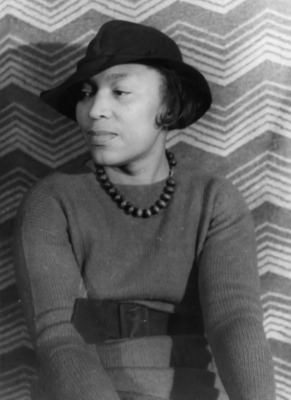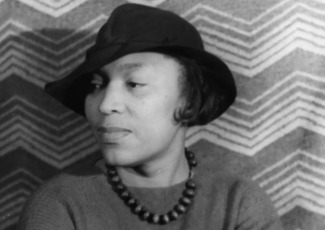
Zora Neale Hurston was born on January 7, 1891, in Notasulga, Alabama. Hurston became one of the most successful and acclaimed African American female writers of the 20th century. Over a career that spanned more than 30 years, she published four novels, two books of folklore, an autobiography, numerous short stories, essays, articles, and plays.
Hurston moved with her family to Eatonville, Florida when she was still a toddler. Established in 1887, the rural community near Orlando was the nation’s first incorporated black township. In Eatonville, Hurston was never made to feel inferior, and she could see the evidence of black achievement all around her. She could look to town hall and see African American men, including her father, John Hurston, formulating the laws that governed Eatonville. She could look to the Sunday schools of the town’s two churches and see African American women, including her mother, Lucy Potts Hurston, directing the Christian curricula. She could look to the porch of the village store and see men and women sharing their worlds in the form of colorful, engaging stories.
Hurston had a fiery intellect, an infectious sense of humor, and “the gift,” as one friend put it, “of walking into hearts.” Hurston used these talents, and dozens more, to elbow her way into the Harlem Renaissance of the 1920s, befriending such luminaries as poet Langston Hughes and popular singer/actress Ethel Waters.
Hurston graduated from Barnard College in 1928 with a degree in anthropology. By 1935, she had published several short stories and articles, as well as a novel (Jonah’s Gourd Vine) and a well-received collection of black Southern folklore (Mules and Men). But the late 1930s and early ’40s marked the real zenith of her career. She published her masterwork, Their Eyes Were Watching God, in 1937; Tell My Horse, her study of Caribbean Voodoo practices, in 1938; and another masterful novel, Moses, Man of the Mountain, in 1939. When her autobiography, Dust Tracks on a Road, was published in 1942, Hurston finally received the well-earned acclaim that had long eluded her. That year, she was profiled in Who’s Who in America, Current Biography, and Twentieth Century Authors. She went on to publish another novel, Seraph on the Suwanee, in 1948.
Despite her success, Hurston never received the financial rewards she deserved, consequently when she died from a stroke on January 28, 1960, her neighbors in Fort Pierce, Florida, had to take up a collection for her funeral. The collection didn’t yield enough to pay for a headstone, so Hurston was buried in a grave that remained unmarked.
In the summer of 1973, a young writer named Alice Walker traveled to Fort Pierce to place a marker on the grave of the author who had so inspired her own work. At the end of a dead end street, Walker found the Garden of Heavenly Rest, a segregated cemetery, abandoned and overgrown with yellow-flowered weeds. Walker bravely entered the snake-infested cemetery where Hurston’s remains had been laid to rest. Wading through waist-high weeds, she soon stumbled upon a sunken rectangular patch of ground that she determined to be Hurston’s grave. Borrowing from a Jean Toomer poem, she dressed the marker up with a fitting epitaph: “Zora Neale Hurston: A Genius of the South.”
Resources
- The Official Website of Zora Neal Hurston zoranealehurston.com
- Encyclopedia of Alabama encyclopediaofalabama.org/article/zora-neale-hurston
- Encyclopedia Britannica www.britannica.com/biography/Zora-Neale-Hurston
- Photo courtesy of the Library of Congress, Prints & Photographs Division, Carl Van Vechten Collection, [reproduction number, e.g., LC-USZ62-54231]


